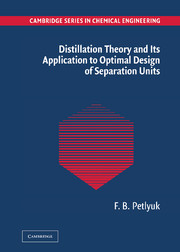Book contents
- Frontmatter
- Contents
- Preface
- Acknowledgements
- Nomenclature
- 1 Phase Equilibrium and Its Geometric Presentation
- 2 Basic Concepts of Distillation
- 3 Trajectories of Distillation in Infinite Columns Under Infinite Reflux
- 4 Trajectories of Thermodynamically Reversible Distillation
- 5 Distillation Trajectories and Conditions of Mixture Separability in Simple Infinite Columns at Finite Reflux
- 6 Distillation Trajectories in Infinite Complex Columns and Complexes
- 7 Trajectories of the Finite Columns and Their Design Calculation
- 8 Synthesis of Separation Flowsheets
- Short Glossary
- Index
Preface
Published online by Cambridge University Press: 08 August 2009
- Frontmatter
- Contents
- Preface
- Acknowledgements
- Nomenclature
- 1 Phase Equilibrium and Its Geometric Presentation
- 2 Basic Concepts of Distillation
- 3 Trajectories of Distillation in Infinite Columns Under Infinite Reflux
- 4 Trajectories of Thermodynamically Reversible Distillation
- 5 Distillation Trajectories and Conditions of Mixture Separability in Simple Infinite Columns at Finite Reflux
- 6 Distillation Trajectories in Infinite Complex Columns and Complexes
- 7 Trajectories of the Finite Columns and Their Design Calculation
- 8 Synthesis of Separation Flowsheets
- Short Glossary
- Index
Summary
This book is devoted to distillation theory and its application. Distillation is the most universal separation technique. Industrial distillation consumes a considerable part of the world power output. The distillation theory enables one to minimize power and capital costs and thus opens up new ways of designing economical separation units. The most important constituent of the distillation theory is the geometric approach, which reveals general rules governing the variation of component concentrations along the distillation column. In other words, it provides general rules for the arrangement of distillation trajectories in the so-called concentration space, in which every point represents some mixture composition. A considerable part of the book is concerned with these general rules, which are used as the basis in developing new methods and algorithms for the optimal design of separation units.
The geometric approach to distillation was put forward by the German scientists Ostwald and Schreinemakers in the early twentieth century. During the years that followed, it has been developed by scientists from various countries. However, until recently, the geometric approach found little use in the design of distillation units. The progress in this field was made by developing the pure computational approach, more specifically, ways of describing the liquid–vapor equilibrium and algorithms for solving sets of distillation equations. This approach has been fruitful: it has resulted in universal computer programs that enable one to design a distillation column (system) of any type for separation of any kind of mixture.
- Type
- Chapter
- Information
- Publisher: Cambridge University PressPrint publication year: 2004



